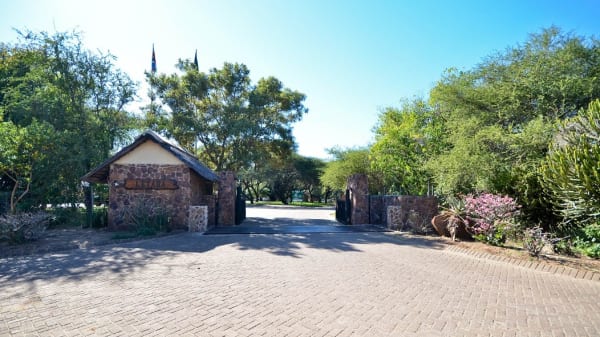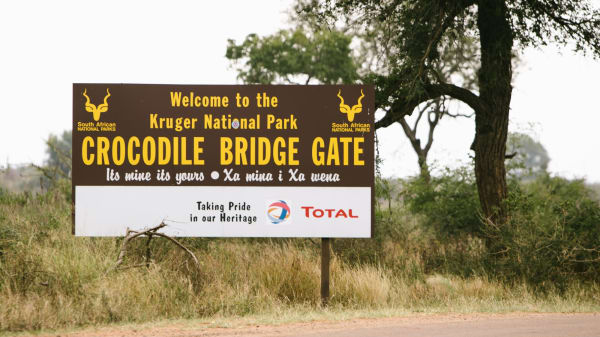The Kruger National Park is one of the largest game reserves in Africa and lies in the north-east of South Africa. It covers an area of 19,485 square kilometres (7,523 square miles) in the provinces of Limpopo and Mpumalanga in northeastern South Africa, and extends 360 kilometres (220 miles) from north to south and 65 kilometres (40 miles) from east to west.
To the west and the south of the Kruger National Park are the two South African provinces of Limpopo and Mpumalanga. Phalaborwa in Limpopo is the only town in South Africa that borders the Kruger National Park. To the north is Zimbabwe and to the east is Mozambique. The Park is now part of the Great Limpopo Transfrontier Park - a peace park that links Kruger National Park with the Gonarezhou National Park in Zimbabwe and with the Limpopo National Park in Mozambique.
The two rivers north and south of the park; the Limpopo and the Crocodile respectively, act as its natural boundaries. To the east the Lebombo Mountains separate it from Mozambique. Its western boundary runs parallel with this range, roughly 65 kilometres (40 miles) in distance. The park varies in altitude between 200 metres (660 ft.) in the east and 840 metres (2,760 ft.) in the south-west near Berg-en-Dal. The highest point in the park is here, a hill called Khandzalive. Several rivers run through the park from west to east, including the Sabie, Olifants, Crocodile, Letaba, Luvuvhu and Limpopo Rivers.
The park is part of the Kruger to Canyons Biosphere, an area designated by the United Nations Educational, Scientific and Cultural Organization (UNESCO) as an International Man and Biosphere Reserve.
The park has nine main gates allowing entrance to the different camps.
The Kruger National Park is an all year round destination due to its warm climate. Whatever time of year you decide to visit you will not be disappointed as each season is unique and highlights its own beauty.
Winter months do offer the best game viewing due to good visibility as the grass is low, bushes and trees are sparse and the wildlife migrates to waterholes, dams and rivers to drink.
The day time temperatures are generally warm but the evenings can get quite cold. One needs to pack a combination of cool and warm clothing to be suitably comfortable at all times.
The wet summer months showcase lush bushveld, migrant birds, newborn wildlife and full waterholes bursting with activity. Game viewing is a bit more difficult in the summer months as the vegetation is dense, making it bit tougher to locate, spot and observe the wildlife.
Temperatures soar during the summer months so it’s advisable to travel in an air-conditioned vehicle. Die-hard camping enthusiasts may not be perturbed by the rain and heat, but for the average tourist air-conditioned accommodation may not be a bad idea.
The climate of the Kruger National Park and Lowveld is subtropical. Summer days are humid and hot with temperatures often soaring to above 38 °C (100 °F). The rainy season is from October until May. The dry winter season is the ideal time to visit this region for various reasons. There is less chance of contracting malaria and the days are milder.
The summer months in Kruger Park are very hot and humid with either continual rains or intermittent afternoon thundershowers. This is a great time to view newborn wildlife.
November through December temperatures range from 16 - 34 °C. January to March temperatures range from 18 to 38 °C. These are normally drier months with very hot daytime temperatures. Migrating birds are a bird watchers dream at this time of the year.
April is Kruger Park's autumn period and the vegetation starts changing from thick lush green bush to slightly sparser browning bush. The temperatures start cooling down at night but daytime is still warm. Scattered thundershowers can be experienced in the afternoons. Temperatures range from 13 - 28 °C.
May to August are the Kruger Park’s winter months experiencing cold temperatures at night and at dawn and chilly late afternoons as well as early mornings. This period is very dry in the bush and vegetation becomes totally brown and trees are sparse. Visibility during game drives is enhanced due to the sparser vegetation which provides good game viewing and the game is generally concentrated around water sources. Temperatures range from 9 - 26 °C. July to October is the end of the dry season and the malaria-carrying mosquitoes are dormant.
September to October is the Kruger Park’s spring season and is the height of the dry season with hot dry winds and sparse vegetation. The rivers and dams are low with high concentrations of game which can often be viewed with ease. The first rains usually start towards the end of October.
The Kruger National Park offers a fantastic tourism experience that combines some of South Africa's best features, a large diversity of bushveld, fauna and flora and superb game viewing. Whether you're planning adventurous game drives, a rural camping retreat, bird watching or tranquil hours spent relaxing watching sunsets and incredible scenery, this will be a wonderful safari holiday full of magical memories.


